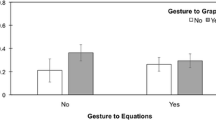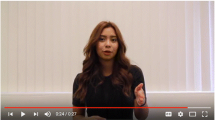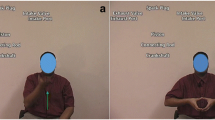Abstract
Spatial thinking is an essential part of science, technology, engineering, and mathematics (STEM), domains that entail external spatial representations such as 2D graphics, 3D models, and—the focus here—gestures. University students (a) read aloud information about the geological concepts of strike and dip, (b) completed strike and dip tasks, and (c) explained these concepts to another student via audio and video. Gestural patterns varied across reading, audio, and video contexts in interaction with participant variables of spatial skill and prior geology coursework. Only novices gestured during reading, interpreted as novices’ attempts to aid their own conceptual understanding of new information. All participant groups produced different gestural patterns in audio versus video contexts, suggesting the communicative intent of many gestures.
Access this chapter
Tax calculation will be finalised at checkout
Purchases are for personal use only
Preview
Unable to display preview. Download preview PDF.
Similar content being viewed by others
References
National Research Council: Learning to think spatially: GIS as a support system in the K-12 curriculum. National Academy Press, Washington (2006)
Stieff, M.: Mental rotation and diagrammatic reasoning in science. Learning and Instruction 17, 219–234 (2007)
Tversky, B.: Spatial schemas in depictions. In: Gattis, M. (ed.) Spatial schemas and abstract thought, pp. 79–112. MIT Press, Cambridge (2001)
Liben, L.S.: Education for spatial thinking. In: Damon, W., Lerner, R. (series eds.), Renninger, K.A., Sigel, I.E. (vol. eds.). Handbook of child psychology, 6th edn. Child psychology in practice, vol. 4, pp. 197–247. Wiley, Hoboken (2006)
Kastens, K.A., Rivet, A.: Using analogical mapping to assess the affordances of scale models used in Earth and environmental science education. In: Hölscher, C., et al. (eds.) Spatial Cognition VII. LNCS (LNAI), vol. 6222, pp. 112–124. Springer, Heidelberg (2010)
Crowder, E.M., Newman, D.: Telling what they know: The role of gesture and language in children’s science explanations. Pragmatics and Cognition 1, 341–376 (1993)
Hegarty, M., Mayer, S., Kriz, S., Keehner, M.: The role of gestures in mental animation. Spatial Cognition and Computation 5, 333–356 (2005)
Kastens, K.A., Manduca, C.A., Cervato, C., Frodeman, R., Goodwin, C., Liben, L.S., Mogk, D.W., Spangler, T.C., Stillings, N.A., Titus, S.: How geoscientists think and learn. EOS Transactions American Geophysical Union 90, 265–272 (2009)
Kastens, K.A., Ishikawa, T.: Spatial thinking in the geosciences and cognitive sciences: A cross-disciplinary look at the intersection of the two fields. In: Manduca, C.A., Mogk, D.W. (eds.) Earth and mind: How geologists think and learn about the Earth, pp. 53–76. The Geological Society of America, Boulder (2006)
Kastens, K.A., Rivet, A.: Multiple modes of inquiry in Earth science. The Science Teacher 75, 26–31 (2008)
Kastens, K.A., Agrawal, S., Liben, L.S.: Research in science education: The role of gestures in geoscience teaching and learning. Journal of Geoscience Education 54, 262–268 (2008)
Singer, M., Radinsky, J., Goldman, S.R.: The role of gesture in meaning construction. Discourse Processes 45, 365–386 (2008)
Kastens, K.A., Agrawal, S., Liben, L.S.: How students and field geologists reason in integrating spatial observations from outcrops to visualize a 3-D geological structure. International Journal of Science Education 31, 365–394 (2009)
Liben, L.S., Christensen, A.E., Kastens, K.A.: Spatial foundations of science education: The illustrative case of instruction on introductory geological concepts. Cognition and Instruction (forthcoming)
Piaget, J., Inhelder, B.: The child’s conception of space. Norton, New York (1956)
Hostetter, A.B., Alibali, M.W.: Raise your hand if you’re spatial: Relations between verbal and spatial skills and gesture production. Gesture 7, 73–95 (2007)
Goodwin, C.: Environmentally coupled gestures. In: Duncan, S., Cassell, J., Levy, E. (eds.) Gesture and dynamic dimensions of language, pp. 195–212. John Benjamins, Amsterdam (2007)
Roth, W.-M.: Gestures: The leading edge in literacy development. In: Saul, E. (ed.) Crossing borders in literacy and science instruction: Perspectives on theory and practice, pp. 48–70. International Reading Association, Newark (2004)
Roth, W.-M., Lawless, D.: Scientific investigations, metaphorical gestures and the emergence of abstract scientific concepts. Learning and Instruction 12, 285–304 (2002)
Broaders, S.C., Cook, S.W., Mitchell, Z., Goldin-Meadow, S.: Making children gesture brings out implicit knowledge and leads to learning. Journal of Experimental Psychology: General 136, 539–550 (2007)
Church, R.B., Goldin-Meadow, S.: The mismatch between gesture and speech as an index of transitional knowledge. Cognition 23, 43–71 (1986)
Garber, P., Goldin-Meadow, S.: Gesture offers insights into problem-solving in adults and children. Cognitive Science 26, 817–831 (2002)
Liben, L.S.: Educational applications of geographic information systems: A developmental psychologist’s perspective. In: Barstow, D. (ed.) First national conference on the educational applications of geographic information systems, pp. 44–49. TERC, Cambridge (1995)
Liben, L.S., Golbeck, S.L.: Performance on Piagetian horizontality and verticality tasks: Sex related differences in knowledge of relevant physical phenomena. Developmental Psychology 20, 595–606 (1984)
Liben, L.S.: Performance on Piagetian spatial tasks as a function of sex, field dependence, and training. Merrill-Palmer Quarterly 24, 97–110 (1978)
Thomas, H., Lohaus, A.: Modeling growth and individual differences in spatial tasks. Monographs of the Society for Research in Child Development 58(9), Serial No. 237 (1993)
Liben, L.S.: The Piagetian water-level task: Looking beneath the surface. In: Vasta, R. (ed.) Annals of Child Development, vol. 8, pp. 81–143. Jessica Kingsley Publishers, London (1991)
Thomas, H., Jamison, W., Hummel, D.D.: Observation is insufficient for discovering that the surface of still water is invariably horizontal. Science 181, 173–174 (1973)
Rebelsky, F.: Adult perception of the horizontal. Perceptual and Motor Skills 19, 371–374 (1964)
Sholl, M.J., Liben, L.S.: Illusory tilt and Euclidean schemes as factors in performance on the water-level task. Journal of Experimental Psychology: Learning, Memory and Cognition 21, 1624–1638 (1995)
De Lisi, R., McGillicuddy-De Lisi, A.V.: Individual differences in adolescents’ horizontality representation: Associations with vocational major and gender. Merrill-Palmer Quarterly 34, 437–449 (1988)
Shea, D.L., Lubinski, D., Benbow, C.P.: Importance of assessing spatial ability in intellectually talented young adolescents: A 20-year longitudinal study. Journal of Educational Psychology 93, 604–614 (2001)
U.S. Geologic Survey. (n.d.), http://geomaps.wr.usgs.gov/parks/gmap/gmap3.html (Retrieved October 6, 2007)
Bakeman, R., Quera, V.: Analyzing interaction: Sequential analysis with SDIS and GSEQ. Cambridge University Press, New York (1995)
Landis, J.R., Koch, G.G.: The measurement of observer agreement for categorical data. Biometrics 33, 159–174 (1977)
Ehrlich, S.B., Levine, S.C., Goldin-Meadow, S.: The importance of gesture in children’s spatial reasoning. Developmental Psychology 42, 1259–1268 (2006)
Goldin-Meadow, S., Cook, S.W., Mitchell, Z.A.: Gesturing gives children new ideas about math. Psychological Science 20, 267–272 (2009)
Cook, S.W., Mitchell, Z., Goldin-Meadow, S.: Gesturing makes learning last. Cognition 106, 1047–1058 (2008)
Valenzeno, L., Alibali, M.W., Klatzky, R.: Teachers’ gestures facilitate students’ learning: A lesson in symmetry. Contemporary Educational Psychology 28, 187–204 (2003)
Kastens, K.A., Liben, L.S., Agrawal, S.: Epistemic actions in science education. In: Freksa, C., Newcombe, N.S., Gärdenfors, P., Wölfl, S. (eds.) Spatial Cognition VI. LNCS (LNAI), vol. 5248, pp. 202–215. Springer, Heidelberg (2008)
Alibali, M.W., Flevares, L.M., Goldin-Meadow, S.: Assessing knowledge conveyed in gesture: Do teachers have the upper hand? Journal of Educational Psychology 89, 183–193 (1997)
Goldin-Meadow, S., Alibali, M.W., Church, R.B.: Transitions in concept acquisition: Using the hand to read the mind. Psychological Review 100, 279–297 (1993)
McNeill, D., Cassell, J., McCullough, K.E.: Communicative effects of speech-mismatched gesture. Research on Language and Social Interaction 27, 223–237 (1994)
Author information
Authors and Affiliations
Editor information
Editors and Affiliations
Rights and permissions
Copyright information
© 2010 Springer-Verlag Berlin Heidelberg
About this paper
Cite this paper
Liben, L.S., Christensen, A.E., Kastens, K.A. (2010). Gestures in Geology: The Roles of Spatial Skills, Expertise, and Communicative Context . In: Hölscher, C., Shipley, T.F., Olivetti Belardinelli, M., Bateman, J.A., Newcombe, N.S. (eds) Spatial Cognition VII. Spatial Cognition 2010. Lecture Notes in Computer Science(), vol 6222. Springer, Berlin, Heidelberg. https://doi.org/10.1007/978-3-642-14749-4_11
Download citation
DOI: https://doi.org/10.1007/978-3-642-14749-4_11
Publisher Name: Springer, Berlin, Heidelberg
Print ISBN: 978-3-642-14748-7
Online ISBN: 978-3-642-14749-4
eBook Packages: Computer ScienceComputer Science (R0)




